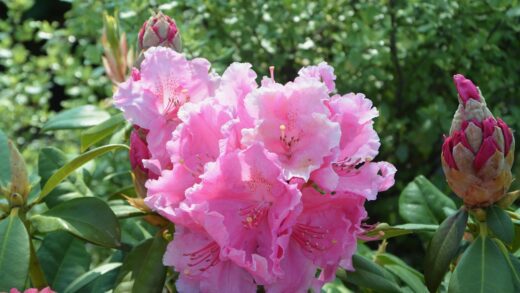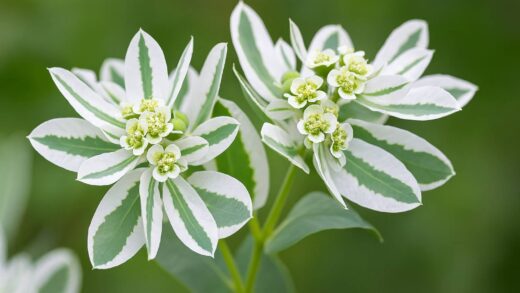While the dwarf iris is known for its hardiness and general resistance to problems, it is not entirely immune to the threats posed by various diseases and pests. A vigilant gardener who knows what to look for can often catch these issues early, preventing them from causing significant damage to the plants. The most effective approach to managing these problems is rooted in prevention, which involves creating a healthy growing environment that naturally discourages pathogens and pests. Proper planting depth, good air circulation, and excellent soil drainage are the cornerstones of a proactive pest and disease management strategy for these beautiful spring bloomers.
The most significant and pervasive threat to the health of dwarf irises is rhizome rot, also known as soft rot. This is not a single disease but rather a condition caused by a bacterial pathogen, Erwinia carotovora, which thrives in anaerobic, waterlogged conditions. The infection typically begins in the rhizome, turning it into a soft, mushy, and foul-smelling mass. Above the ground, the symptoms manifest as the yellowing and wilting of the leaf fan, which will often collapse at the base. The primary cause of this devastating condition is planting the rhizomes too deeply or in poorly drained, heavy soil that remains wet for extended periods.
Another common issue is fungal leaf spot, which is caused by various fungal pathogens. This disease appears as small, discolored spots on the leaves, which may enlarge over time and develop a dark border with a tan or grayish center. While leaf spot is rarely fatal to the plant, a severe infection can reduce the photosynthetic area of the leaves, which can weaken the plant over time by diminishing the amount of energy it can store in its rhizome for the following year’s growth. Fungal diseases like this are most prevalent in humid, damp weather and in plantings that are overcrowded, which restricts air circulation.
Rust is another fungal disease that can affect irises, although it is less common on the dwarf varieties. It presents as small, reddish-brown pustules on the undersides of the leaves. Similar to leaf spot, rust thrives in moist conditions and can weaken the plant if left unchecked. Maintaining good garden sanitation by removing and destroying infected leaves can help to control its spread. Ensuring adequate spacing between plants to promote good airflow is also a key preventative measure against both leaf spot and rust.
Preventative care is always the best line of defense against these diseases. This starts with planting only healthy, firm rhizomes and ensuring they are planted at the correct depth with their tops exposed to the sun. Amending heavy soils to improve drainage is non-negotiable. Furthermore, a thorough cleanup of old iris foliage in the autumn is crucial, as the dead leaves can harbor fungal spores and pest eggs over the winter, which would then re-infect the plants in the spring.
More articles on this topic
Common pests affecting the iris
The most notorious and destructive pest specific to irises is the iris borer (Macronoctua onusta). The adult form is a nocturnal moth that lays its eggs on iris foliage and other garden debris in the late summer and autumn. In the spring, the eggs hatch, and the tiny caterpillars crawl up the leaves and begin to tunnel their way down towards the rhizome. As they travel, they leave behind tell-tale signs such as dark, watery streaks or notched, ragged edges on the leaves. Once they reach the rhizome, they hollow it out, causing extensive damage and creating entry points for the bacteria that cause soft rot.
Aphids are another common pest that can be found on dwarf irises, particularly on new growth and flower buds. These small, sap-sucking insects can cause distortion of the leaves and flowers and can also act as vectors for transmitting viral diseases from one plant to another. While a small infestation is unlikely to cause significant harm to a healthy plant, large populations can weaken the plant and mar the appearance of the blooms. They are often found in dense clusters and can be controlled with a strong spray of water or with insecticidal soap.
Slugs and snails can also be a nuisance, especially in damp, shaded gardens. They are attracted to the tender new growth of irises in the spring and can chew ragged holes in the leaves and flowers, often leaving behind their signature slimy trails. While the damage is mostly cosmetic, a severe infestation can damage emerging flower buds. Control methods include setting out slug baits (using caution if pets are present), hand-picking them off the plants at night, or creating barriers with diatomaceous earth or crushed eggshells around the base of the plants.
Less common but still a potential issue are thrips, which are tiny, slender insects that can infest iris flowers, causing discoloration and streaking on the petals. Their feeding can also lead to deformed buds that fail to open properly. Spider mites, which thrive in hot, dry conditions, can also occasionally be a problem, causing a stippled or bronzed appearance on the foliage. Maintaining good plant health and monitoring for early signs of these pests is the best way to prevent widespread infestations.
More articles on this topic
Integrated pest management strategies
An integrated pest management (IPM) approach is the most sustainable and effective way to deal with pests and diseases affecting dwarf irises. This strategy prioritizes preventative measures and biological controls over the routine use of chemical pesticides. The foundation of IPM is maintaining plant health, as vigorous, healthy plants are naturally more resistant to attacks. This involves providing the irises with their ideal growing conditions: full sun, excellent drainage, and appropriate nutrition.
Good garden sanitation is a cornerstone of IPM. This practice involves the diligent removal of dead leaves and garden debris, especially in the autumn. This cleanup is critically important for controlling the iris borer, as it eliminates the overwintering sites for their eggs. By clearing away all old iris foliage after it has died back, you can significantly reduce the borer population for the following year. Similarly, removing and destroying any leaves that show signs of fungal leaf spot or rust will help to prevent the spread of these diseases.
Encouraging natural predators in your garden is another key component of IPM. Birds, ladybugs, lacewings, and predatory wasps are all natural enemies of common garden pests like aphids. You can attract these beneficial creatures to your garden by planting a diverse range of flowering plants, providing a source of water, and avoiding the use of broad-spectrum chemical insecticides, which kill beneficial insects just as effectively as they kill pests. A healthy garden ecosystem is often capable of keeping pest populations in check naturally.
When direct intervention is necessary, always start with the least toxic control method first. For aphids, a strong jet of water from a hose is often enough to dislodge them. If further control is needed, insecticidal soap or neem oil are effective and have a lower impact on beneficial insects than synthetic pesticides. For iris borers, the most effective control is to manually search for and crush the caterpillars inside the leaves when you see the first signs of their tunneling in the spring, before they have a chance to reach the rhizome.
Dealing with rhizome rot
Rhizome rot is the most serious disease that can affect dwarf irises, but if it is caught early, the plant can often be saved. The first step is to carefully lift the entire affected clump out of the ground, even if only one fan of leaves appears to be dying. You must act swiftly to prevent the rot from spreading through the interconnected rhizomes to the rest of the clump. Once the clump is out of the ground, gently wash away all the soil so you can clearly inspect the condition of all the rhizomes.
Using a sharp, clean knife, you must surgically remove all the affected parts of the rhizomes. Any tissue that is soft, brown, discolored, or has a foul smell must be cut away until you are left with only clean, white, firm rhizome tissue. Be ruthless in this process; leaving even a small amount of infected tissue behind will allow the rot to continue spreading. After cutting, it is a good practice to dip or dust the cut surfaces with a fungicide or a 10% bleach solution (one part bleach to nine parts water) to kill any remaining bacteria and help the wound to dry and seal.
After the surgical cleanup, do not replant the rhizomes immediately. Instead, lay them out in a dry, sunny, and well-ventilated location for several days to a week. This allows the cut surfaces to dry out and form a callus, which acts as a protective barrier against new infections when the rhizome is replanted. This curing process is a critical step that should not be skipped, as it significantly increases the chances of the salvaged rhizome’s survival.
When you are ready to replant the salvaged, healthy rhizome pieces, do not plant them back in the same location without first addressing the underlying cause of the rot. The original planting spot likely has poor drainage or was too shady. You must either heavily amend the soil in that spot with sand and compost to improve its drainage or, preferably, choose a new location for the irises that has better sun exposure and naturally well-draining soil. Replanting them in the same problematic conditions will almost certainly lead to a recurrence of the rot.
Preventing future outbreaks
Preventing future outbreaks of pests and diseases is a continuous process that relies on maintaining optimal growing conditions and vigilant garden practices. The single most important preventative measure is to ensure your irises are planted in a location with at least six hours of direct sunlight and in soil with exceptionally good drainage. This combination of sun and drainage helps to keep the rhizomes dry and healthy, creating an environment that is naturally inhospitable to the bacteria and fungi that cause rot and other diseases.
Regularly dividing your iris clumps every three to five years is another crucial preventative practice. Overcrowded clumps suffer from poor air circulation, which traps moisture and creates a humid microclimate that is ideal for the development of fungal diseases like leaf spot. Crowding also leads to increased competition for nutrients and light, which can weaken the plants and make them more susceptible to problems. Division not only rejuvenates the plants but also provides an opportunity to inspect the rhizomes for any early signs of borers or rot.
Be mindful of your watering habits. As dwarf irises are drought-tolerant, you should water them infrequently but deeply during their spring growth period and avoid watering them altogether during their summer dormancy. Always water at the base of the plant to keep the foliage as dry as possible. Applying a thin layer of mulch, such as gravel or coarse sand, around the base of the plants can also help to keep the area immediately around the rhizome dry and discourage slugs and snails.
Finally, practice a strict regimen of garden sanitation. In the autumn, after the first hard frost has killed the foliage, cut all the iris leaves back to a few inches above the ground and remove them from the garden. Do not add diseased foliage to your compost pile. This cleanup removes the primary overwintering sites for iris borer eggs and fungal spores, drastically reducing the potential for problems in the following spring. This simple act of autumn tidiness is one of the most effective preventative measures you can take.
📷 Jerzy Opioła, CC BY-SA 4.0, via Wikimedia Commons

















